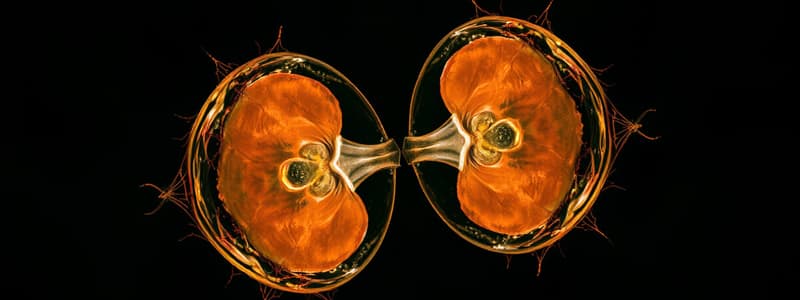Podcast
Questions and Answers
What is mitosis?
What is mitosis?
Division of cells' genetic material in eukaryotes.
What does acrocentric refer to?
What does acrocentric refer to?
One chromosomal arm is significantly longer than another.
What occurs during anaphase?
What occurs during anaphase?
Sister chromatids are separated and move to the poles of the cell.
What is an aster?
What is an aster?
What is the purpose of the cell plate?
What is the purpose of the cell plate?
What is the role of the centriole?
What is the role of the centriole?
What is a centromere?
What is a centromere?
What is chromatin?
What is chromatin?
What is a chromosome?
What is a chromosome?
What is cleavage in relation to cell division?
What is cleavage in relation to cell division?
What is the cleavage furrow?
What is the cleavage furrow?
What is condensation in genetics?
What is condensation in genetics?
What is the function of a contractile ring?
What is the function of a contractile ring?
What is a cyclin?
What is a cyclin?
What is cytokinesis?
What is cytokinesis?
What does density-dependent inhibition refer to?
What does density-dependent inhibition refer to?
What is the function of a histone?
What is the function of a histone?
What is interphase?
What is interphase?
What is a karyotype?
What is a karyotype?
What is the role of a kinetochore?
What is the role of a kinetochore?
What are kinetochore fibers?
What are kinetochore fibers?
What does metacentric mean?
What does metacentric mean?
What happens during metaphase?
What happens during metaphase?
What is a microtubule?
What is a microtubule?
What is the role of spindle fibers?
What is the role of spindle fibers?
What does telocentric refer to?
What does telocentric refer to?
What occurs during telophase?
What occurs during telophase?
What is a telomere?
What is a telomere?
What does tubulin refer to?
What does tubulin refer to?
What is an oncogene?
What is an oncogene?
What is crossing over?
What is crossing over?
What is cytokinesis 1 and 2 of meiosis?
What is cytokinesis 1 and 2 of meiosis?
What is meiotic formation of eggs called?
What is meiotic formation of eggs called?
What is nondisjunction?
What is nondisjunction?
What is synapsis?
What is synapsis?
What is a polar body?
What is a polar body?
What is gametogenesis?
What is gametogenesis?
Flashcards are hidden until you start studying
Study Notes
Mitosis and Cell Division
- Mitosis is the process of dividing genetic material in eukaryotic cells.
- Sister chromatids separate during anaphase, moving to opposite poles, each now considered a chromosome.
- Prophase involves chromosome condensation, separation of centrosomes, and potential nuclear envelope fragmentation.
- Telophase marks the arrival of chromosomes at poles, forming new nuclear membranes and preparing for cytokinesis.
Chromosomal Structures
- Acrocentric chromosomes have one significantly longer arm.
- Metacentric chromosomes have arms of similar lengths.
- The centromere is the DNA region connecting sister chromatids.
- Aster structures form around centrosomes during mitosis, with astral rays radiating from the centrosphere.
Cytokinesis
- In animal cells, cytokinesis involves a cleavage furrow formed by a contractile ring of actin and myosin.
- Plant cells form a cell plate during cytokinesis, derived from cell wall materials transported to the division site.
Genetic Material and Packaging
- Chromatin is a complex of DNA, RNA, and proteins that condenses DNA for cell division.
- Nucleosomes are the basic units of DNA packaging, consisting of DNA wrapped around histone proteins.
- The telomere protects chromosome ends from deterioration, consisting of repetitive nucleotide sequences.
Cell Cycle and Phases
- Interphase includes G1, S (DNA replication), and G2 phases.
- Cyclins accumulate at the G1/S checkpoint, signaling the onset of mitosis.
- Density-dependent inhibition refers to the growth of a population being regulated by its density.
Types of Cell Division
- Meiosis includes two rounds of division: Meiosis I separates homologous chromosomes, while Meiosis II separates sister chromatids.
- Crossing over occurs during prophase I of meiosis, exchanging genetic material between homologous chromosomes at chiasmata.
Genetic Variation and Cancer
- Oncogenes have the potential to contribute to cancer, while proto-oncogenes are normal genes that may mutate.
- Tumor suppressor genes regulate cell growth and prevent tumor formation.
Transport Mechanisms
- Diffusion is the passive movement of molecules from higher to lower concentration areas.
- Active transport moves molecules against their concentration gradient, requiring energy.
- Exocytosis and endocytosis are processes for moving substances into and out of cells.
Specialized Cellular Functions
- Spermatogenesis involves producing sperm cells through meiotic divisions.
- Oogenesis refers to the formation of ova (egg cells).
- Follicles are structures within the ovaries that support oocyte development.
Miscellaneous Terms
- Karyotype is the map of chromosomes in a cell.
- Kinetochore fibers attach spindle apparatus to chromosomes, crucial for proper chromosome segregation.
- Chiasma represents contact points between non-sister chromatids during crossing over.
Studying That Suits You
Use AI to generate personalized quizzes and flashcards to suit your learning preferences.





